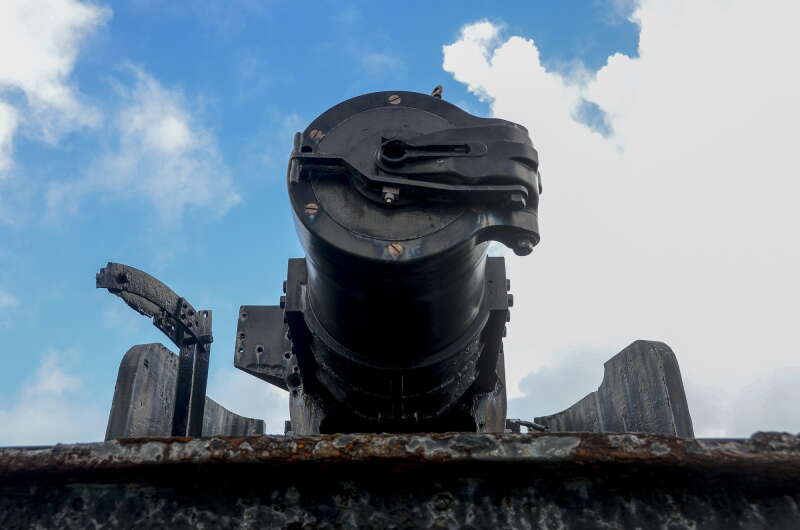Created: Jan 30, 2014 07:00 AM (Updated: Jan 30, 2014 07:01 AM)
St. David's Battery was a fixed battery of rifled breech-loader artillery guns, built and manned by the Royal Garrison Artillery and the Royal Engineers, the Bermuda Militia Artillery and the Bermuda Volunteer Engineers, part of the Bermuda Garrison of the British Army. Completed in 1910, it was one of the last of a large number of forts and fortified gun batteries built by the British Army.
Part of Bermuda’s national park system, St David’s Battery on St David’s Island, in St George’s was built in the first decade of the last century with a pair of six-inch and two 9.2-inch rifled breech loaders which can still be seen at the site. The purpose of St David’s Battery was to be the patron saint of the Narrows Channel, the only way ships could enter the inner harbours of Bermuda at Murray’s Anchorage, Grassy Bay at Dockyard, the Great Sound and Hamilton Harbour. Its guns were aimed to stop an enemy from gaining access to the Narrows and that remained its function until the end of coastal defence in 1956. In 1939, as the Second World War dawned, the men of the Bermuda Militia Artillery (commanded by British officers seconded from the Royal Artillery with black non-commissioned and enlisted men) in concert with the white Bermuda Volunteer Engineers were tasked with duty of manning the battery — for a time the Island’s only defences from Axis assault. The BMA expanded rapidly over the summer of 1939, from a single battery of three officers and 103 other ranks and 11 other ranks serving as instructors and equipment maintenance personnel. In a matter of hours on August 24, it was embodied by Proclamation of the Acting Commander-in-Chief and St David’s Battery was put on an operational footing. By October, a new battery had been established at Warwick Camp using the six-inch gun that had been kept for practice in the BMA Drill Shed at St George’s, with another gun, coming from Britain later in 1940. The BMA had served with distinction on the Somme in the First World War, where a number of the soldiers lost their lives. While the all-white Bermuda Volunteer Rifle Corps preceded the BMA into the Second World War — being re-enlisted into the Lincolnshire Regiment — some members of the BMA and the Bermuda Militia Infantry served in garrison and POW camps in North Africa in the “Bermuda Contingent” of the Caribbean Regiment. All local forces were amalgamated into the Bermuda Regiment in 1963.

St. David's Battery was a fixed battery of rifled breech-loader artillery guns, built and manned by the Royal Garrison Artillery and the Royal Engineers, the Bermuda Militia Artillery and the Bermuda Volunteer Engineers, part of the Bermuda Garrison of the British Army. Completed in 1910, it was one of the last of a large number of forts and fortified gun batteries built by the British Army.
St. David's Battery was a fixed battery of rifled breech-loader artillery guns, built and manned by the Royal Garrison Artillery and the Royal Engineers, the Bermuda Militia Artillery and the Bermuda Volunteer Engineers, part of the Bermuda Garrison of the British Army. Completed in 1910, it was one of the last of a large number of forts and fortified gun batteries built by the British Army.
St. David's Battery was a fixed battery of rifled breech-loader artillery guns, built and manned by the Royal Garrison Artillery and the Royal Engineers, the Bermuda Militia Artillery and the Bermuda Volunteer Engineers, part of the Bermuda Garrison of the British Army. Completed in 1910, it was one of the last of a large number of forts and fortified gun batteries built by the British Army.
St. David's Battery was a fixed battery of rifled breech-loader artillery guns, built and manned by the Royal Garrison Artillery and the Royal Engineers, the Bermuda Militia Artillery and the Bermuda Volunteer Engineers, part of the Bermuda Garrison of the British Army. Completed in 1910, it was one of the last of a large number of forts and fortified gun batteries built by the British Army.
St. David's Battery was a fixed battery of rifled breech-loader artillery guns, built and manned by the Royal Garrison Artillery and the Royal Engineers, the Bermuda Militia Artillery and the Bermuda Volunteer Engineers, part of the Bermuda Garrison of the British Army. Completed in 1910, it was one of the last of a large number of forts and fortified gun batteries built by the British Army.
St. David's Battery was a fixed battery of rifled breech-loader artillery guns, built and manned by the Royal Garrison Artillery and the Royal Engineers, the Bermuda Militia Artillery and the Bermuda Volunteer Engineers, part of the Bermuda Garrison of the British Army. Completed in 1910, it was one of the last of a large number of forts and fortified gun batteries built by the British Army.
St. David's Battery was a fixed battery of rifled breech-loader artillery guns, built and manned by the Royal Garrison Artillery and the Royal Engineers, the Bermuda Militia Artillery and the Bermuda Volunteer Engineers, part of the Bermuda Garrison of the British Army. Completed in 1910, it was one of the last of a large number of forts and fortified gun batteries built by the British Army.
St. David's Battery was a fixed battery of rifled breech-loader artillery guns, built and manned by the Royal Garrison Artillery and the Royal Engineers, the Bermuda Militia Artillery and the Bermuda Volunteer Engineers, part of the Bermuda Garrison of the British Army. Completed in 1910, it was one of the last of a large number of forts and fortified gun batteries built by the British Army.



